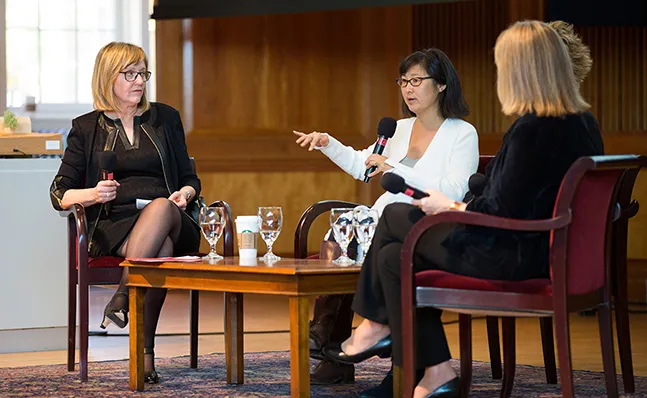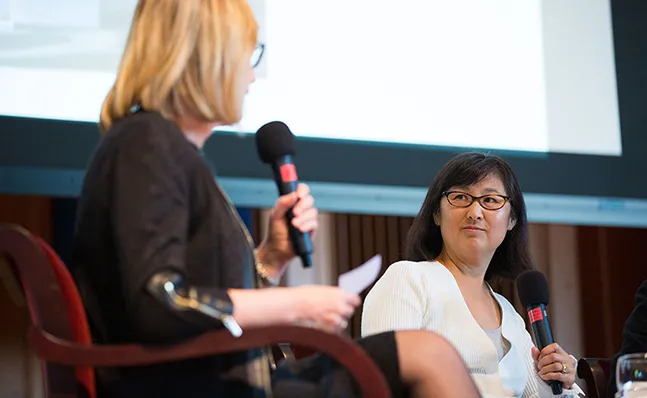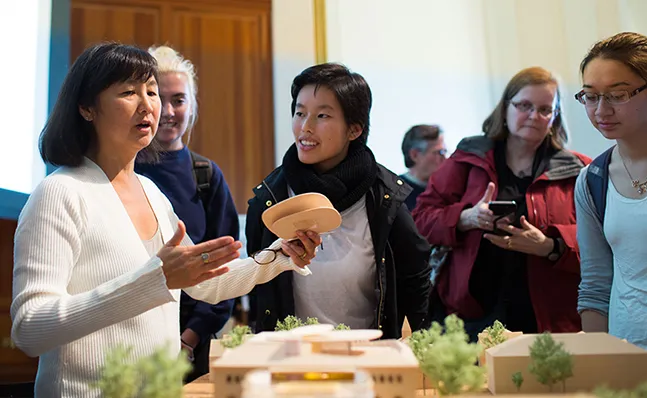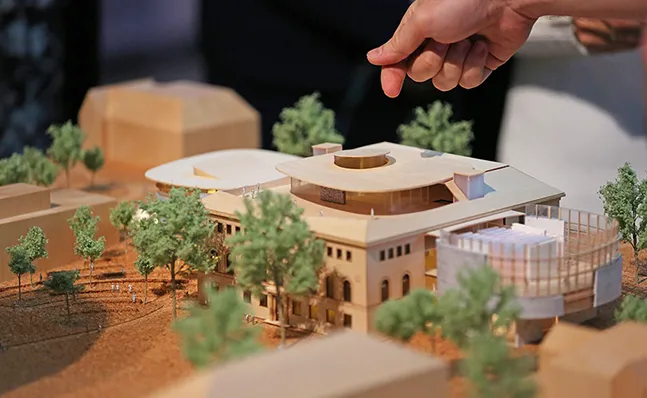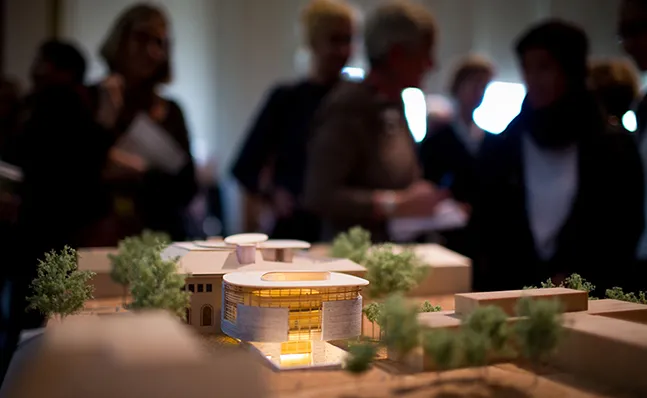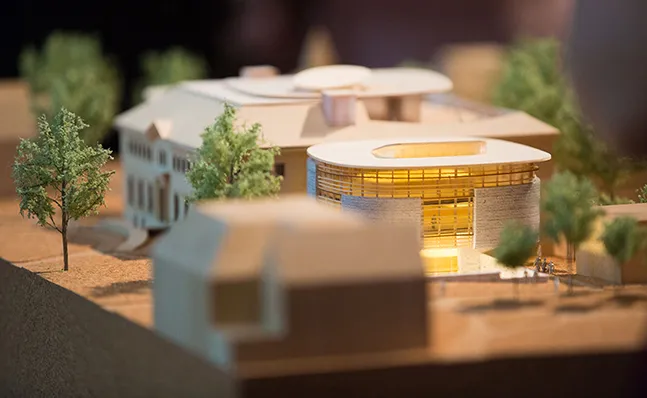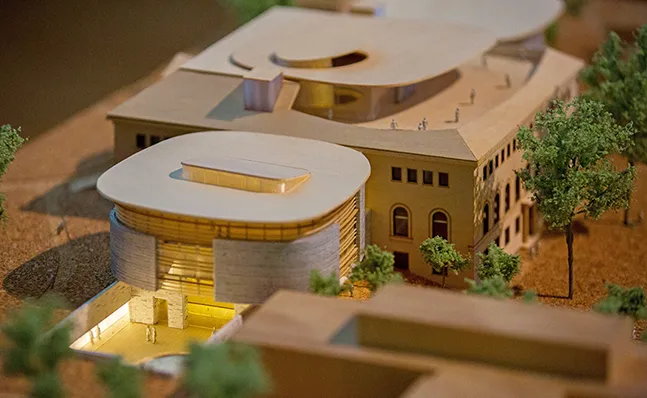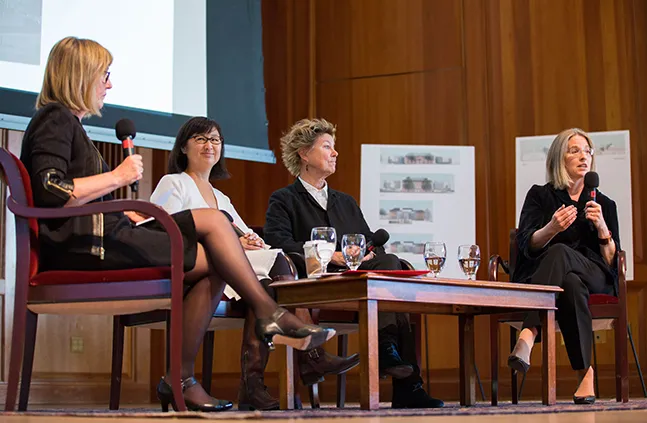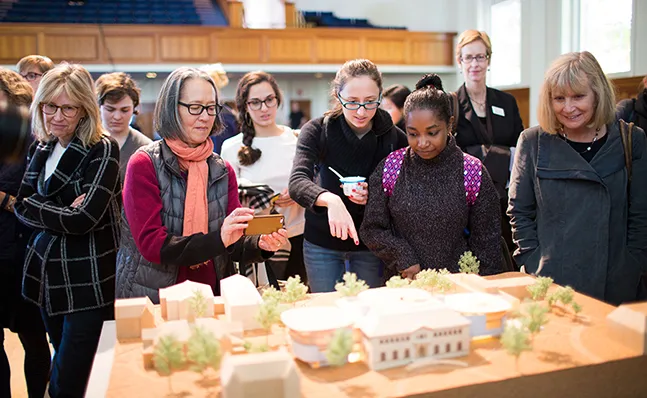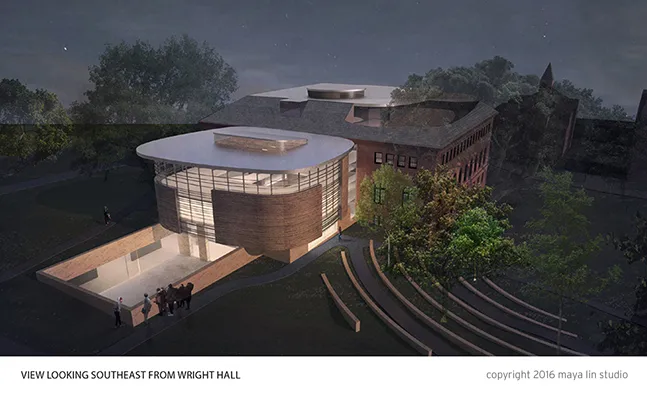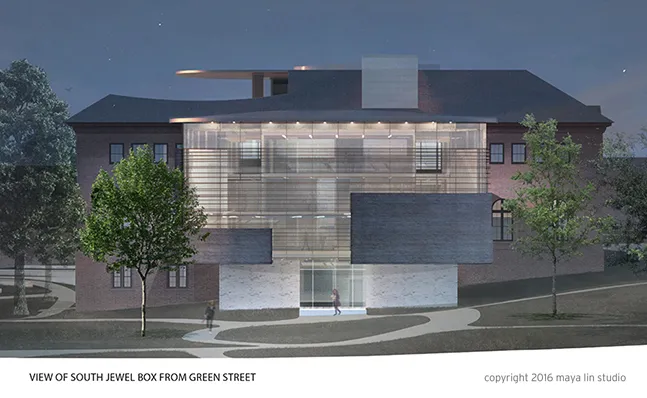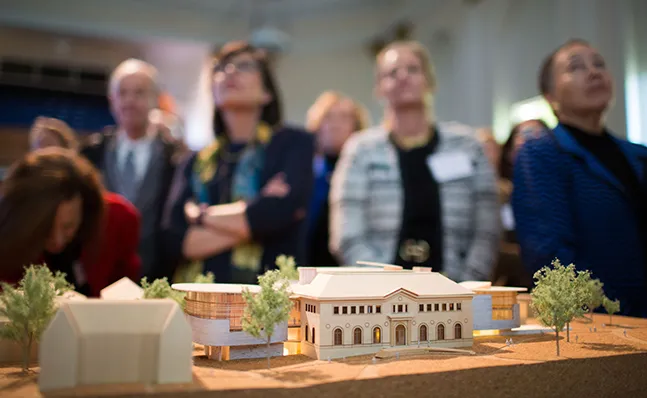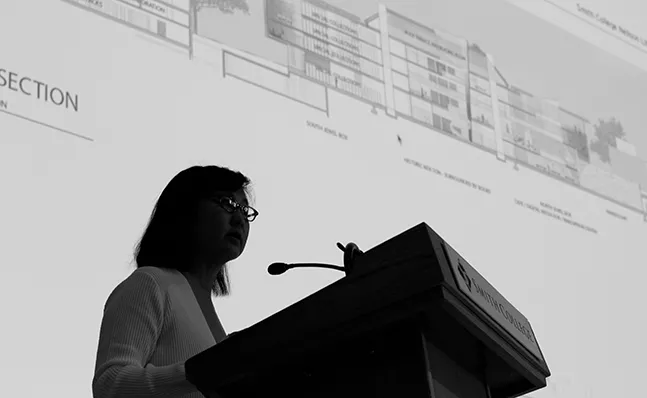The New Neilson
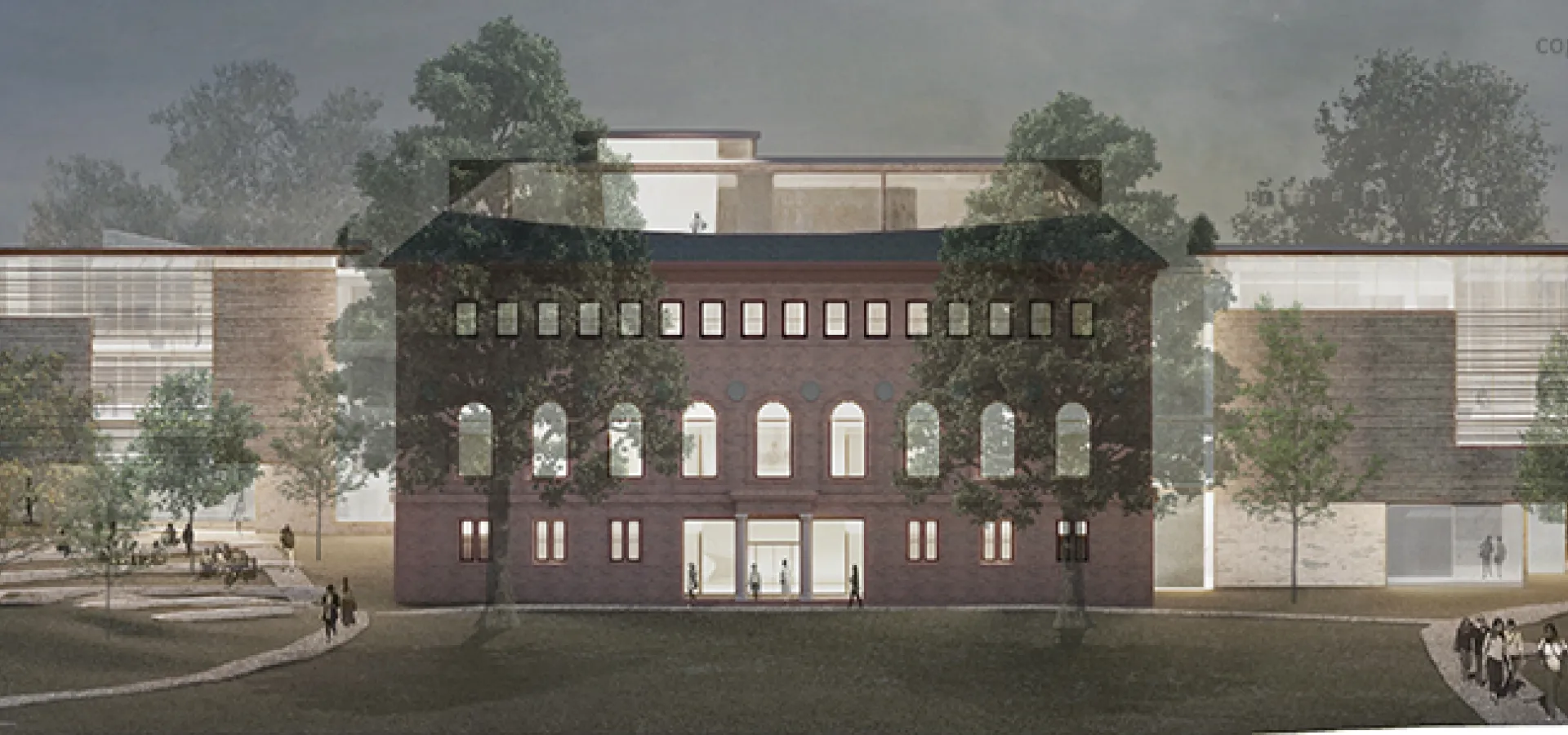
For more than a century, Neilson Library has been a crossroads of Smith College’s intellectual community, where scholars and students spend quiet hours studying and exploring the archives and collections in their quest for knowledge. Faculty and staff also meet there to share research, craft new assignments and map the future of the curriculum.
Holding steady to its mission of advancing teaching, learning and discovery for students and faculty, the library has grown and responded to the needs of the times: expanding its collections, developing an array of digital services, and fostering a core of librarians who are essential partners in teaching and learning. But the facilities of the current building are reaching their limits.
Smith’s Next Frontier
Smith has always been at the forefront of pedagogy, most recently in introducing an engineering program that is the first of its kind at a liberal arts college for women and in establishing academic concentrations that combine classroom work with real-world experiences.
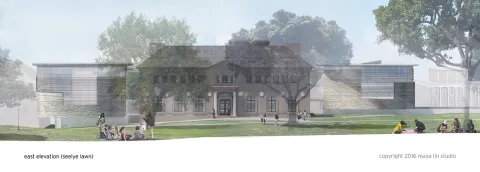
The college’s next frontier will be to create what President Kathleen McCartney has called a “library for the 21st century.” Around the world, colleges and universities are discussing the future of academic libraries. Studies show that libraries remain critical curated spaces and are no longer simply “boxes of books,” according to Sarah Thomas ’70, vice president for the Harvard Library. To appeal to a new generation of students, college libraries must be flexible and responsive, according to Thomas, providing spaces that can be transformed at a moment’s notice to accommodate different needs. They must provide immediate and seamless access to information through state-of-the-art digital technology, and they must offer patrons open social spaces for discussion and studying in groups.
Design Reveal
Smith President Kathleen McCartney was joined on stage in Sweeney Concert Hall by designer Maya Lin, landscape architect Edwina Von Gal and Janette Blackburn from the Shepley Bulfinch architectural firm to reveal the design for the reimagined Neilson Library, October 14, 2016.
Library Program Committee
Charge: To identify and prioritize such building elements as user spaces, library services, physical collections, and academic support services and centers, and make recommendations to the president and board, who will make final decisions.
- Katherine Rowe, Provost and Dean of Faculty; chair
- Nancy Bradbury, Professor of English Language and Literature; Libraries Feasibility Committee
- Betsy Carpenter, Development and Campaign Director
- Patrick Coby, Professor of Government
- Charlie Conant, Senior Project Manager, Facilities Management; liaison to architect
- Deborah Duncan ’77, Trustee
- Nalini Easwar, Professor of Physics
- John Eue, Associate Vice President for Public Affairs
- Sarah Evans ’18
- Elizabeth Eveillard, Chair, Board of Trustees, ex officio
- Madeleine Fackler ’80, Trustee
- Barbara Kellum, Professor of Art
- Kimberly Kono, Associate Professor of East Asian Languages and Literatures
- Tom Laughner, Director of Educational Technology Services
- Donna Lisker, Dean of the College and Vice President for Campus Life
- Christopher Loring, Director of Libraries
- Steve Moga, Assistant Professor of Landscape Studies
- Roger Mosier, Associate Vice President for Facilities Management
- Beth Myers, Director of Special Collections
- Cornelia Pearsall, Professor of English Language and Literature
- Judith Pelham ’67, Trustee
- Barbara Polowy, Head of Hillyer Art Library; staffing the committee
- Danielle Ramdath, Associate Dean of the Faculty
- Dano Weisbord, Director of Campus Sustainability and Space Planning
- Maria Wood AC
Library Design Committee
Charge: The Library Design Committee will work with the team of Maya Lin Studio + Shepley Bulfinch to ensure that the college’s design and aesthetic ambitions for the new Neilson Library are realized in the context of its program requirements as well as the campus as a whole.
The committee will guide input from the Smith community to the design process and provide formal feedback to the Maya Lin + Shepley Bulfinch team at milestones throughout the design process. In addition, the committee will be responsible for maintaining alignment between the program, design and budget.
- Kathleen McCartney, President; chair
- Deborah Berger ’86, Trustee
- Nancy Bradbury, Professor of English Language and Literature
- Elizabeth Mugar Eveillard ’69, Chair, Board of Trustees, ex officio
- Michael Howard, Vice President for Finance and Administration
- Barbara Kellum, Professor of Art
- Christopher Loring, Director of Libraries
- Steve Moga, Assistant Professor of Landscape Studies
- Roger Mosier, Associate Vice President for Facilities Management
- Susan Novick ’81, Trustee
- Judith Pelham ’67, Trustee
- Beth Raffeld, Vice President for Development
- Katherine Rowe, Provost and Dean of the Faculty
Architect Selection Committee
Charge: To recommend a slate of potential architects to the Buildings and Grounds Committee of the Board of Trustees.
- Kathleen McCartney, President; Chair
- Sanford Belden, Trustee
- Nancy Bradbury, Professor of English Language and Literature; Libraries Feasibility Committee
- Charles Conant, Senior Project Manager, Facilities Management
- John Davis, Alice Pratt Brown Professor of Art
- Elizabeth Mugar Eveillard ’69, Chair, Board of Trustees, ex officio
- Patricia DiBartolo, Professor of Psychology and Director of the Science Center
- Andrew Guswa, Engineering
- Michael Howard, Vice President for Finance and Administration
- Christopher Loring, Director of Libraries
- Roger Mosier, Associate Vice President for Facilities Management
- Lucy Mule, Associate Professor of Education and Child Study
- Beth Myers, Director of Special Collections
- Lois Perelson-Gross ’83, Trustee
- Beth Raffeld, Vice President for Development
- Katherine Rowe, Provost and Dean of Faculty
- Frazer Ward, Associate Professor of Art History and Dean of the Junior Class
- Tom Bernard, Director of Special Projects, staff support
Working Groups
Charge: To identify and prioritize such building elements as user spaces, library services, physical collections, and academic support services and centers, and make recommendations to the president and board, who will make final decisions. Members.
Program Committee-Led Working Groups
Vision
Nancy Bradbury, Professor of English Language and Literature; Betty Eveillard, Chair, Board of Trustees; Christopher Loring, Director of the Libraries; Steve Moga, Assistant Professor of Landscape Studies; Katherine Rowe, Provost and Dean of Faculty (convener)
Collections
Patrick Coby, Professor of Government; Deborah Duncan '77, Trustee; Barbara Kellum, Professor, Art Department; Rob O'Connell, Director of Discovery & Accesss; Beth Myers, Director of Special Collection (convener); Danielle Ramdath, Associate Dean of the Faculty; Amy Rhodes, Associate Professor, Geosciences; Pamela Skinner, Head of Collection Development; Maria Wood, Ada Comstock student
User Study Spaces
Sika Berger, User Experience Librarian; Sarah Evans '18; Kim Kono, Associate Professor of East Asian Languages and Literature; Brendan O'Connell, Instructional Technology Librarian; Barbara Polowy, Head of the Hillyer Art Library (convener); Maria Wood, Ada Comstock student
Building Co-Occupants
Charlie Conant, Senior Project Manager, Facilities Management; Nalini Easwar, Professor of Physics; Sarah Evans '18; Madeleine Fackler '80, Trustee; Anne Houston, Director for Teaching, Learning & Research; Elisa Lanzi, Director of Digital Strategies & Services; Thomas C. Laughner, Director of Educational Technology Information (convener); Christopher Loring, Director of the Libraries; Roger Mosier, Associate Vice President for Facilities Management; Cornelia Pearsall, Professor of English Language and Literature; Katherine Rowe, Provost and Dean of Faculty; Dano Weisbord, Director of Campus Sustainability and Space Planning
Teaching/Seminar/Instruction Spaces and Technology
Martin Antonetti, Rare Books and Marketing/Outreach Director; Betsy Carpenter, Development and Campaign Director; Floyd Cheung, Associate Professor of English; Yasmin Chin Eisenhauer, Instructional Technologist; Anne Houston, Director for Teaching, Learning & Research (convener); Donna Lisker, Dean of the College and Vice President for Campus Life (subbed as needed by Tina Azengle, Senior Program Administrator to support student engagement); Miriam Neptune, Digital Scholarship Librarian; Judith Pelham '67, Trustee
Sustainability
Steve Moga, Assistant Professor of Landscape Studies; Roger Mosier, Associate Vice President for Facilities Management; Janet Spongberg, Josten Circulation Coordinator; Dano Weisbord, Director of Campus Sustainability and Space Planning (convener)
Library-Led Working Groups
Service Model(s)
Anne Houston, Director for Teaching, Learning & Research (convener); Reese Julian, Circulation Manager; Elisa Lanzi, Director of Digital Strategies & Services; Thomas C. Laughner, Director o f Educational Technology Information; Christopher Loring, Director of the Libraries; Beth Myers, Director of Special Collections; Rob O'Connell, Director of Discovery & Access
Special Collections
Martin Antonetti, Curator of Rare Books; Rosetta Cohen, Sylvia Dlugasch Bauman Professor of Education & American Studies; Maida Goodwin, Collections Archivist; Beth Myers, Director of Special Collections (convener); Rob O'Connell, Director of Discovery & Access; Nanci Young, College Archivist
Staff Spaces/Functions
Anne Houston, Director for Teaching, Learning & Research; Elisa Lanzi, Director of Digital Strategies & Services; Christopher Loring, Director of the Libraries; Beth Myers, Director of Special Collections; Rob O'Connell, Director of Discovery & Access (convener); Barbara Polowy, Head of the Hillyer Art Library
